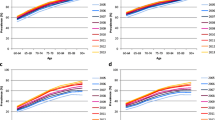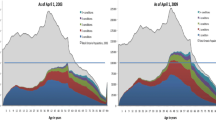Abstract
Objectives
Our study examined how life years spent in multimorbidity changed over a period of 10 years (2005–2014) and whether morbidity expansion or compression has taken place. There is a little evidence on whether life years gained due to increasing life expectancy are spent in good health, or if they are accompanied by morbidity expansion.
Methods
The analyses are based on German administrative claims data. Multimorbidity was defined as a combination of at least six chronic conditions and polypharmacy. After having estimated age-standardized prevalence, time trends for life years with and without multimorbidity, and the proportion of life years spent in multimorbidity (morbidity ratio) were estimated.
Results
Prevalence proportions of multimorbidity rose continuously. Increasing life expectancies were accompanied by increasing life years with multimorbidity, decreasing multimorbidity-free life years, and by an increasing morbidity ratio.
Conclusions
The lifespan spent in multimorbidity was increasing over time. Our findings indicate a growing burden of multimorbidity and an increasing proportion of life years with multiple chronic conditions. It can be concluded that an expansion of morbidity in absolute and in relative terms has occurred. The findings stress the importance of prevention, healthy lifestyles, and improved medical care strategies meeting the specific requirements of patients with multimorbidity.

Similar content being viewed by others
References
Bundesministerium für Gesundheit (2009) Gesetzliche Krankenversicherung: Mitglieder, mitversicherte Angehörige und Krankenstand. Jahresdurchschnitte 1998 bis 2008. http://www.bmg.bund.de/fileadmin/redaktion/pdf_statistiken/krankenversicherung/KM1JD2004-pdf-5112.pdf. Accessed 25 July 2016
Bundesministerium für Gesundheit (2015) Gesetzliche Krankenversicherung: Mitglieder, mitversicherte Angehörige und Krankenstand. Jahresdurchschnitt 2014. http://www.bmg.bund.de/fileadmin/dateien/Downloads/Statistiken/GKV/Mitglieder_Versicherte/KM1_JD_2014.pdf. Accessed 25 July 2016
Chakravarty EF, Hubert HB, Krishnan E, Bruce BB, Lingala VB, Fries JF (2012) Lifestyle risk factors predict disability and death in healthy aging adults. Am J Med 125(2):190–197. doi:10.1016/j.amjmed.2011.08.006
Chiang CL (1984) The life table and its applications. Krieger, Malabar
Crimmins EM, Beltrán-Sánchez H (2011) Mortality and morbidity trends: is there compression of morbidity? J Gerontol B Psychol Sci Soc Sci 66(1):75–86. doi:10.1093/geronb/gbq088
Dhalwani NN, O‘Donovan G, Zaccardi F, Hamer M, Yates T, Davies M, Khunti K (2016) Long terms trends of multimorbidity and association with physical activity in older English population. Int J Behav Nutr Phys Act 13:8. doi:10.1186/s12966-016-0330-9
Doblhammer G, Kreft D, Dethloff A (2012) Life years gained. Long-term trends in mortality by causes of death in Germany and in an international perspective (Gewonnene Lebensjahre. Langfristige Trends der Sterblichkeit nach Todesursachen in Deutschland und im internationalen Vergleich). Bundesgesundheitsblatt Gesundheitsforschung Gesundheitsschutz 55(4):448–458. doi:10.1007/s00103-012-1455-x
Drivsholm T, Eplov LF, Davidsen M, Jorgensen T, Ibsen H, Hollnagel H, Borch-Johnsen K (2006) Representativeness in population-based studies: a detailed description of non-response in a Danish cohort study. Scand J Public Health 34(6):623–631. doi:10.1080/14034940600607616
Freedman VA, Wolf DA, Spillman BC (2016) Disability-free life expectancy over 30 Years: a growing female disadvantage in the US population. Am J Public Health 106(6):1079–1085. doi:10.2105/AJPH.2016.303089
Fries JF (1980) Aging, natural death, and the compression of morbidity. N Engl J Med 303(3):130–135. doi:10.1056/NEJM198007173030304
Fries JF (2012) The theory and practice of active aging. Curr Gerontol Geriatr Res 2012:420637. doi:10.1155/2012/420637
Geyer S (2016) Morbidity compression: a promising and well-established concept? Int J Public Health 61(7):727–728. doi:10.1007/s00038-016-0853-5
Geyer S, Jaunzeme J (2014) Möglichkeiten und Grenzen von Befragungsdaten und Daten gesetzlicher Krankenversicherungen. In: Swart E, Ihle P, Gothe H, Matusiewicz D (eds) Routinedaten im Gesundheitswesen: Handbuch Sekundärdatenanalyse: Grundlagen, Methoden, und Perspektiven, 2rd edn. Verlag Hans Huber, Bern, pp 223–233
Gruenberg EM (1977) The failures of success. Milbank Mem Fund Q 55(1):3–24. doi:10.1111/j.1468-0009.2005.00400.x
Harrison C, Britt H, Miller G, Henderson J (2014) Examining different measures of multimorbidity, using a large prospective cross-sectional study in Australian general practice. BMJ Open 4(7):e004694. doi:10.1136/bmjopen-2013-004694
Jagger C, Cox B, Le Roy S, EHEMU (2006) Health expectancy calculation by the Sullivan Method. Third Edition. EHEMU Technical Report
Jaunzeme J, Eberhard S, Geyer S (2013) Wie “repräsentativ” sind GKV-Daten? Demografische und soziale Unterschiede und Ähnlichkeiten zwischen einer GKV-Versichertenpopulation, der Bevölkerung Niedersachsens sowie der Bundesrepublik am Beispiel der AOK Niedersachsen (How “representative” are SHI (statutory health insurance) data? Demographic and social differences and similarities between an SHI-insured population, the population of Lower Saxony, and that of the Federal Republic of Germany using the example of the AOK in Lower Saxony). Bundesgesundheitsblatt Gesundheitsforschung Gesundheitsschutz 56(3):447–454. doi:10.1007/s00103-012-1626-9
Jeune B, Eriksen ML, Andersen-Ranberg K, Bronnum-Hansen H (2015) Improvement in health expectancy at ages 50 and 65 in Denmark during the period 2004–2011. Scand J Public Health 43(3):254–259. doi:10.1177/1403494815569104
Lagergren M, Johnell K, Schon P, Danielsson M (2016) Healthy life years in old age: Swedish development 1980–2010 according to different health indicators. Scand J Public Health 44(1):55–61. doi:10.1177/1403494815605195
Manton KG (1982) Changing concepts of morbidity and mortality in the elderly population. Milbank Mem Fund Q Health Soc 60(2):183–244
Meslé F, Vallin J (2006) The health transition: trends and prospects. In: Caselli G, Vallin J, Wunsch GJ (eds) Demography: analysis and synthesis. a treatise in population studies, vol 2. Academic, New York, pp 247–259
Navickas R, Petric V, Feigl AB, Seychell M (2016) Multimorbidity: what do we know? What should we do? JOC 6(1):4–11. doi:10.15256/joc.2016.6.72
Nusselder WJ, Looman CWN (2004) Decomposition of differences in health expectancy by cause. Demography 41(2):315–334. doi:10.1353/dem.2004.0017
R Team RC (2014) A language and environment for statistical computing. R Foundation for Statistical Computing, Vienna
Ramond-Roquin A, Haggerty J, Lambert M, Almirall J, Fortin M (2016) Different multimorbidity measures result in varying estimated levels of physical quality of life in individuals with multimorbidity: a cross-sectional study in the general population. Biomed Res Int 2016:7845438. doi:10.1155/2016/7845438
Rinne ST, Wong ES, Lemon JM, Perkins M, Bryson CL, Liu C (2015) Survey nonresponders incurred higher medical utilization and lower medication adherence. Am J Manag Care 21(1):e1–e8
Robert Koch-Institut (2015) Gesundheit in Deutschland. Gesundheitsberichterstattung des Bundes—Gemeinsam getragen von RKI und Destatis, Berlin
Robine J, Jagger C (2005) The relationship between increasing life expectancy and healthy life expectancy. Ageing Horizons 3:14–21
Sinnige J, Braspenning J, Schellevis F, Stirbu-Wagner I, Westert G, Korevaar J (2013) The prevalence of disease clusters in older adults with multiple chronic diseases-a systematic literature review. PLoS One 8(11):e79641. doi:10.1371/journal.pone.0079641
StataCorp (2013) Stata Statistical Software: Release 13. StataCorp LP, College Station
Sullivan DF (1971) A single index of mortality and morbidity. HSMHA. Health Rep 86(4):347–354
Tetzlaff J, Junius-Walker U, Muschik D, Epping J, Eberhard S, Geyer S (2016) Identifying time trends in multimorbidity—defining multimorbidity in times of changing diagnostic practices. J Public Health. doi:10.1007/s10389-016-0771-2
Trachte F, Sperlich S, Geyer S (2015) Kompression oder Expansion der Morbidität? Entwicklung der Gesundheit in der älteren Bevölkerung (Compression or expansion of morbidity? Development of health among the older population). Z Gerontol Geriatr 48(3):255–262. doi:10.1007/s00391-014-0644-7
Uijen AA, van de Lisdonk EH (2008) Multimorbidity in primary care: prevalence and trend over the last 20 years. Eur J Gen Pract 14(Suppl 1):28–32. doi:10.1080/13814780802436093
Valkonen T (2006) Social inequalities in mortality. In: Caselli G, Vallin J, Wunsch GJ (eds) Demography: analysis and synthesis. a treatise in population studies. Academic, New York, pp 195–206
van Oostrom SH, Gijsen R, Stirbu I, Korevaar JC, Schellevis FG, Picavet HSJ, Hoeymans N (2016) Time trends in prevalence of chronic diseases and multimorbidity not only due to aging: data from general practices and health surveys. PLoS One 11(8):e0160264. doi:10.1371/journal.pone.0160264
van den Bussche H, Scherer M (2011) Das Verbundvorhaben “Komorbidität und Multimorbidität in der hausärztlichen Versorgung” (MultiCare) (The joint research project “Comorbidity and multimorbidity in primary care” (MultiCare)). Z Gerontol Geriatr 44(Suppl 2):73–100. doi:10.1007/s00391-011-0249-3
van den Akker M, Buntinx F, Knottnerus JA (1996) Comorbidity or multimorbidity: what’s in a name? A review of literature. Eur J Gen Pract 2(2):65–70
Violan C, Foguet-Boreu Q, Flores-Mateo G, Salisbury C, Blom J, Freitag M, Glynn L, Muth C, Valderas JM (2014) Prevalence, determinants and patterns of multimorbidity in primary care: a systematic review of observational studies. PLoS One 9(7):e102149. doi:10.1371/journal.pone.0102149
Walter S, Beltran-Sanchez H, Regidor E, Gomez-Martin C, Del-Barrio JL, Gil-de-Miguel A, Subramanian SV, Gil-Prieto R (2016) No evidence of morbidity compression in Spain: a time series study based on national hospitalization records. Int J Public Health. doi:10.1007/s00038-016-0829-5
WHO (2014) Global Status Report on noncommunicable diseases 2014. World Health Organization, Geneva
WHO Collaborating Centre for Drug Statistics Methodology (2015) Guidelines for ATC classification and DDD assignment 2015, Oslo
Willis GB, Smith T, Lee HJ (2013) Do additional recontacts to increase response rate improve physician survey data quality? Med Care 51(10):945–948. doi:10.1097/MLR.0b013e3182a5023d
Acknowledgements
The permission of the Allgemeine Ortskrankenkasse Niedersachsen (AOK Niedersachsen—Statutory Health Insurance of Lower Saxony) to work with the health insurance data is greatly acknowledged. In particular, the support of Jürgen Peter (AOK Niedersachsen) made it possible to carry out the project the data were derived from.
Author information
Authors and Affiliations
Corresponding author
Ethics declarations
Conflict of interest
The authors declare that they have no conflict of interest.
Ethical approval
This article does not contain any studies with human participants or animals performed by any of the authors. The AOK Niedersachsen gave permission to use the data.
Funding
The work done by JT was funded by the AOK Niedersachsen-Statutory Health Insurance of Lower Saxony as part of a project on morbidity compression. The work done by DM was funded by the Ministry of Science and Culture of Lower Saxony as part of the doctoral program GESA: Health-related care for a self-determined life in old age—Theoretical concepts, users’ needs, and responsiveness of the health care system.
Electronic supplementary material
Below is the link to the electronic supplementary material.
Rights and permissions
About this article
Cite this article
Tetzlaff, J., Muschik, D., Epping, J. et al. Expansion or compression of multimorbidity? 10-year development of life years spent in multimorbidity based on health insurance claims data of Lower Saxony, Germany. Int J Public Health 62, 679–686 (2017). https://doi.org/10.1007/s00038-017-0962-9
Received:
Revised:
Accepted:
Published:
Issue Date:
DOI: https://doi.org/10.1007/s00038-017-0962-9




